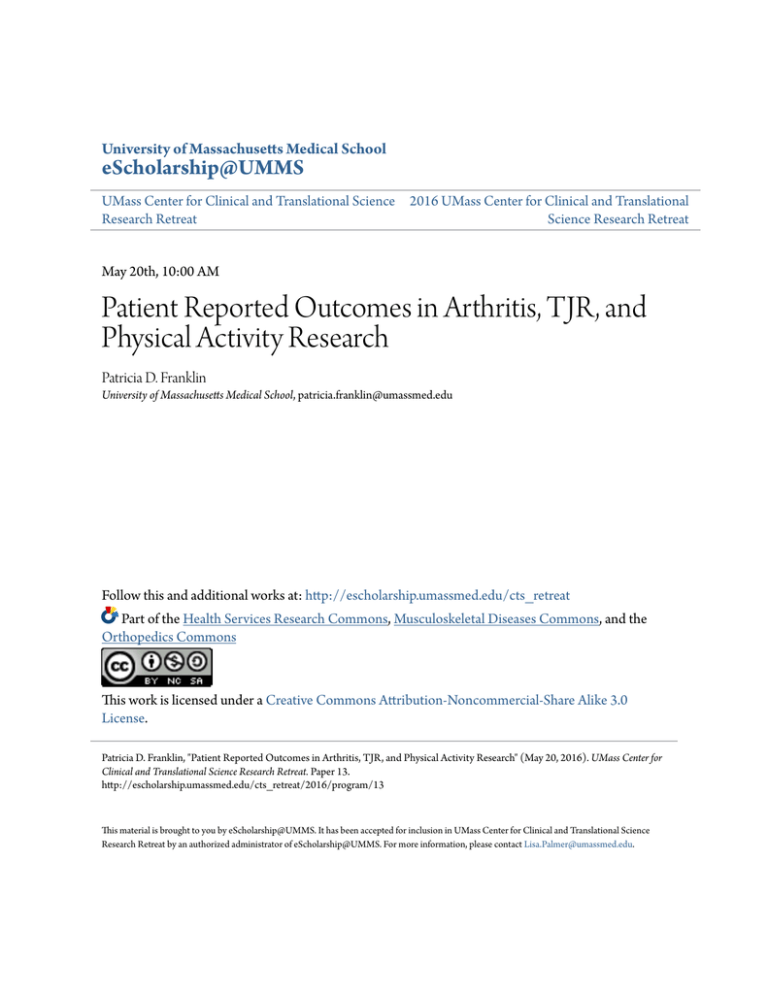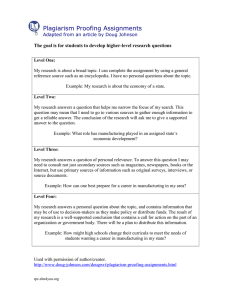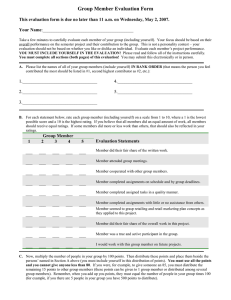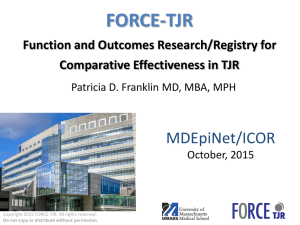
University of Massachusetts Medical School
eScholarship@UMMS
UMass Center for Clinical and Translational Science 2016 UMass Center for Clinical and Translational
Research Retreat
Science Research Retreat
May 20th, 10:00 AM
Patient Reported Outcomes in Arthritis, TJR, and
Physical Activity Research
Patricia D. Franklin
University of Massachusetts Medical School, patricia.franklin@umassmed.edu
Follow this and additional works at: http://escholarship.umassmed.edu/cts_retreat
Part of the Health Services Research Commons, Musculoskeletal Diseases Commons, and the
Orthopedics Commons
This work is licensed under a Creative Commons Attribution-Noncommercial-Share Alike 3.0
License.
Patricia D. Franklin, "Patient Reported Outcomes in Arthritis, TJR, and Physical Activity Research" (May 20, 2016). UMass Center for
Clinical and Translational Science Research Retreat. Paper 13.
http://escholarship.umassmed.edu/cts_retreat/2016/program/13
This material is brought to you by eScholarship@UMMS. It has been accepted for inclusion in UMass Center for Clinical and Translational Science
Research Retreat by an authorized administrator of eScholarship@UMMS. For more information, please contact Lisa.Palmer@umassmed.edu.
Patient Reported Outcomes in
Arthritis, TJR, and Physical Activity
Research
UMMS CCTS Retreat
5.20.16
Patricia D. Franklin, MD MBA MPH
Department of Orthopedics and Physical
Rehabilitation
University of Massachusetts Medical School
Copyright 2015 FORCE-TJR. All rights reserved.
Do not copy or distribute without permission.
Disclosure
• I have no actual or potential conflict of
interest in relation to this
program/presentation.
• Current research funding:
– PCORI
– AHRQ
– NIH/NIAMS
– Zimmer Biomet, Inc.
Copyright 2015 FORCE-TJR. All rights reserved.
Do not copy or distribute without permission.
Today’s Goals
1. Why collect PROs in clinic and research?
2. What are PROs? What do we learn from
them?
3. PRO/physical activity translational research in
OA and TJR at UMMS.
Note: OA/TJR as example; principles apply to
other chronic conditions.
Copyright 2015 FORCE-TJR. All rights reserved.
Do not copy or distribute without permission.
OA patients choose TJR to relieve pain,
improve function
OA is the most common disabling condition
among US adults; affects more than 2/3 of
adults over 65 years.
• Knee and hip OA pain limits mobility
• Total Joint Replacement is the most common
and costly procedure in Medicare budget;
• Use among patients <65 is escalating (now
48% of total)
• >1 million procedures each year in US
Copyright 2015 FORCE-TJR. All rights reserved.
Do not copy or distribute without permission.
New paradigm: patient-reported
outcomes as primary TJR endpoint
“When he [the surgeon] saw the PRO survey, he saw how my
function was, how bad it was….” Patient, age 72, TKR, PA
Copyright 2015 FORCE-TJR. All rights reserved.
Do not copy or distribute without permission.
FORCE-TJR: platform for TJR
outcomes monitoring
Competitive Application: $12 million AHRQ P50 award
Department of Orthopedics and Physical Rehabilitation
University of Massachusetts Medical School (2011-14)
Supplemental grants (AHRQ, PCORI, FDA, NIH)
1. Develop a comprehensive TJR registry with sustainable data
infrastructure for comprehensive TJR outcome monitoring and
feedback to providers.
– UMass is the TJR data coordinating center for the next 20+ years
2. UMass TJR research team conducting comparative effectiveness
research in TJR quality and outcomes.
– Participating on CMS expert panels and national TJR leadership groups
Copyright 2015 FORCE-TJR. All rights reserved.
Do not copy or distribute without permission.
FORCE-TJR: National Cohort of 28,000
patients, >200 Surgeons, 28 States
•
•
•
•
•
75% of surgeons are community
-based
Fellowship-trained, general
orthopedic surgeons
High and low volume
surgeons/hospitals; urban and
rural hospitals
Diverse patients and settings for
first 25,000+ patients define
NATIONAL NORMS on Pre- and
Post- PROs for immediate
benchmarking
Patients <65 years and Medicare
Copyright 2015 FORCE-TJR. All rights reserved.
Do not copy or distribute without permission.
FORCE-TJR: collected across TJR Care Cycle
>28,000 patients
Patient
Surgeon
Before
Surgery
Hospital
Surgery
• PRO
Global: VR12
HOOS/KOOS
• CLINICAL RISKS
Medical &
MSK risks
Demographic
• CLINICAL
Implant
Operative
Notes
Direct to Patient (validate EHR)
30 -90 days
6 months
Annual
• PRO
Pain
• PRO
Global: VR12
HOOS/KOOS
• PRO
Global: VR12
HOOS/KOOS
• CLINICAL
Readmission
Complication
(if any)
• CLINICAL
Complication
(if any)
• CLINICAL
Complication
(if any)
CMS DATA
Copyright 2015 FORCE-TJR. All rights reserved.
Do not copy or distribute without permission.
Revision
PROs completed:
WEB-based
• In Office
• From Home
• On PC or Tablet
(Scannable Paper option)
85% complete Pre and
Post-TJR
Copyright 2015 FORCE-TJR. All rights reserved.
Do not copy or distribute without permission.
2. Patient reported outcome measures
• PROs: "any report of the status of a patient's
health condition that comes directly from the
patient, without interpretation of the patient's
response by a clinician or anyone else.” NQF
• PROs: two major groups
1. Global health status: physical, mental, and
social well-being.
2. Diagnosis-specific patient reported
symptoms, e.g., knee.
Copyright 2015 FORCE-TJR. All rights reserved.
Do not copy or distribute without permission.
SF/VR12, SF36
(John Ware; Rand, 1980s)
• 2 major domains:
Physical Health (PCS) and Emotional Health (MCS) (SF12, 36)
• 8 sub-domains (SF36)
1.
2.
3.
4.
5.
6.
7.
8.
vitality
general health perceptions
physical functioning
bodily pain
physical role functioning
emotional role functioning
social role functioning
mental health
• Secondary value: Poor emotional health is predictor of poor
physical function (PCS) after TJR
Copyright 2015 FORCE-TJR. All rights reserved.
Do not copy or distribute without permission.
PROMIS
http://www.nihpromis.org/
• Physical Function
1.
2.
3.
4.
Physical function
Pain (interference)
Fatigue
Sleep
1.
2.
Anxiety
Depression
• Emotional function
• Social Health
Limitation of Global Function Measure: Low back pain or contralateral
knee/hip disease, COPD, etc. will influence global function.
Copyright 2015 FORCE-TJR. All rights reserved.
Do not copy or distribute without permission.
General: VR12; PROMIS
No attribution to disease
Copyright 2015 FORCE-TJR. All rights reserved.
Do not copy or distribute without permission.
Disease-specific PRO
• Knee/Hip OA
– WOMAC- broadly used in OA assessment
– HOOS/KOOS (includes WOMAC); 42 items
– Five Domains:
1. Pain
2. Activities of Daily Living
3. Symptoms (stiffness)
4. Sport
5. QoL
• 42 items; attribute limitations to KNEE or HIP
• brief “knee/hip health” PRO; AHRQ (Gandek)
Copyright 2015 FORCE-TJR. All rights reserved.
Do not copy or distribute without permission.
Pain/Function in Knees & Hips
KOOS/HOOS
Copyright 2015 FORCE-TJR. All rights reserved.
Do not copy or distribute without permission.
FORCE-TJR Protocols for Successful PRO
Capture integrated with Clinic
1. Flexible IT to interface with patients and clinicians;
diverse settings with varied EMRs.
2. Operational procedures to track patient over time
• Surgeon office to Hospital to Home
3. Risk-adjusted analyses with useful benchmarks based
on representative patients and practices.
Incorporating Patient-Reported Outcomes In Health Care To Engage Patients and
Enhance Care. Lavallee, Chenok, Love, Petersen, Holve, Segal, Franklin PD.
Health Affairs. 2016 Apr 1;35(4):575-82.
Copyright 2015 FORCE-TJR. All rights reserved.
Do not copy or distribute without permission.
How Use PRO data in Clinic and
Research?
Ease of PRO administration; APP
(AHRQ Ancillary; WPI/UMMS
Zheng)
Copyright 2015 FORCE-TJR. All rights reserved.
Do not copy or distribute without permission.
Individual Patient Level
Computer collect/score:
1. Actionable
Real-time scored Function and
Pain as “lab test”
2. Interpretable
Trended across visits
Pre/Post treatments
Norms (colors)
3. Surgeon/ Patient
Review
Shared decisions
Risk factors
Copyright 2015 FORCE-TJR. All rights reserved.
Do not copy or distribute without permission.
Tailored Individual Outcome Estimates
• PCORI; Franklin, Li, Zheng, Ayers
• 2016-2020 ($6.3million)
• Refine individualized models; predicted
outcomes and risks
• Deploy web-based assessment and reports
• Conduct cluster randomized trial among 40
surgeons to define impact on patient/surgeon
shared decision making for knee/hip OA care,
including TJR
Copyright 2015 FORCE-TJR. All rights reserved.
Do not copy or distribute without permission.
Pre-TKR Function: Indicator of
appropriateness/timing?
Site Pre-TKR Patient Profile:
•
National Norm for Healthy = 50
(SD=10) Green arrow
•
•
Site Median PCS = 32
National Median PCS for TJR = 32
(2SD below healthy; Red arrow)
•
•
Site 75th%ile PCS = 38
National 75th%ile PCS = 39
Patient selection matches national norms;
>83% have PCS scores reflecting disability.
Patients in yellow (1SD): evaluate clinical
circumstances warranting TJR.
Copyright 2015 FORCE-TJR. All rights reserved.
Do not copy or distribute without permission.
Pre-op
Implant Surveillance
FDA UO1; Cornell/network of registries
• Understanding
PRO/ pain as an
indicator for underperforming
implants at risk for
revision.
• Supporting postmarket surveillance
Copyright 2015 FORCE-TJR. All rights reserved.
Do not copy or distribute without permission.
Activity (steps/day) post-TKR vary by risk factors;
Association activity== functional gain?
PRE-TKR
steps/day
POST-TKR
steps/day
Pre-TKR
6600
7690
1280
Male
7496
9051
1239
Female
6218
7150
901
Female
Male
Gender diff.
Predicted Post-TKR
steps/day
95% CI
95% CI
7131
6156
8107
9259
7678
10841
2128
228
4027
Copyright 2015 FORCE-TJR. All rights reserved.
Do not copy or distribute without permission.
Change
UMass Kinesiology/Orthopedics
Worcester Gait Lab
• Patterns of activity loss and gait in progression
of OA? Improvement after TKR? THR?
• Mechanism of OA influence on gait/function?
• Correlation with PROs? What incremental
information? What consistent?
• Which gait measures have clinical diagnostic
or treatment value?
Copyright 2015 FORCE-TJR. All rights reserved.
Do not copy or distribute without permission.




